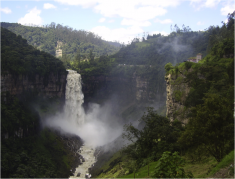A Unique Pathway Under Threat: Colombia's Magdalena River
Gabriel Garcia Marquez, famous Colombian writer and Nobel Prize winner, had an intimate relationship with the Magdalena River. He spent his childhood there, and as an adult he set two novels – Love in the Time of Cholera and The General in His Labyrinth – on it. His descriptions of the river are lyrical – and sometimes surreal. But his love affair with the river speaks to the deep place it holds in the psyche of the Colombian people.
Colombia’s largest and arguably most important river, the Magdalena finds its own unique pathway, born in the mountain ranges of the Andes, where it flows north and empties into the Caribbean Sea. The river supports the Colombian economy: It’s used as transport, sustains many fisheries, and houses many wildlife species. This winding river is also home to mainly endemic and endangered species such as the Grey-legged Night Monkey (Aotus griseimembra) and the neotropical otter (Lontra longicaudis).
And now it’s under threat.
The Colombian government, in conjunction with two Chinese corporations, has created plans that would alter not only the livelihoods of many communities and unique ecosystems, but also the Colombian economy as a whole.
Plans to Dam
On February 16, 2009, the Magdalena River Regional Autonomous Corporation (Cormagdalena), HydroChina, and the China Development Bank Corporation signed an agreement to launch the exploitation and development of the Magdalena River. Initially the Master Plan document was only available in English and Chinese, rendering it inaccessible to most Colombian citizens.
According to this document, the Master Plan takes “navigation, hydropower generation and environmental protection as the key themes, concurrently with other general themes as land improvement (flood control, waterlog control and irrigation), riparian zone use, river course regulation, fishery resources utilization, and recreation.”
The Colombian government and the Chinese corporations plan to privatize the river and build an additional 11 to 15 dams on it. But Colombia’s track record with hydropower is not encouraging: 70% of Colombia’s energy is currently produced by hydroelectric dams, and the most recent, Quimbo Dam, has raised many concerns because of flooding, displacement and the lack of compensation for displaced people. The Master Plan for the Magdalena River claims to consider environmental protection, but in fact it aims to change the course of the river for the benefit of a handful of corporations.
Recent and Current Actions: Mobilization
Now is the time to act. An alarming amount of hydroelectric dams are planned for this ecologically and culturally significant river. The Magdalena River, a source of so much economic opportunity for so many – also carries deep symbolic weight for many Colombians, including Gabriel Garcia Marquez.
“The days were easy for him,” Marquez writes, “as he sat at the rail, watching the motionless alligators sunning themselves on sandy banks, their mouths open to catch butterflies, watching the flocks of startled herons that rose without warning from the marshes, the manatees that nursed their young at large maternal teats and startled the passengers with their woman’s cries. On a single day he saw three bloated, green, human corpses float past, with buzzards sitting on them.”




